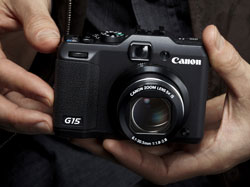Canon Japan has cut its full-year sales forecasts for digital cameras as consumers around the world abandon the high volume, low end of the compact market.

Canon’s chief financial officer, Toshizo Tanaka, attributed at least some of the reduced demand to smartphones: ‘We lowered our camera sales projection because of slower economic growth and an increasing use of smartphones that’s eroding demand,’ he is quoted as telling reporters in a Bloomberg report.
However, low demand in Europe due to the debt crisis and production hold-ups in China have also played a role in reduced global sales.
The decline in sales masks an opportunity for specialists to consolidate their position as experts in a market where demand for feature-rich models is actually expanding.
Camera distributors in 2012/13 will be relying more on the product knowledge and selling skills of specialist retailers in this fundamentally changed product mix. Mass merchants may well re-assess their commitment to a category in decline – specifically the low end compact camera. Consequently, the importance of the photo specialist to their camera suppliers is likely to increase.
Canon has lowered global sales forecasts for Powershot, Ixus and other compact models by 9.5 percent to 19 million units, and for professional-grade EOS models by 4.3 percent to 8.8 million, the company said in a statement. Its profit forecast was also cut 6.4 percent.
While US market researcher IHS predicts global camera sales to slip by 4.3 percent this year to 115 million units, another group, Strategy Analytics, says that global smartphone sales rose by 32 percent, to 146 million units, just in the second quarter.
The more authoritative and reliable figures from CIPA (Camera and Imaging Products Association) paint an even more severe picture of falling camera sales. In unit terms, August 2012 camera production and shipments fell a full 25 percent compared to August 2011. (These are the latest figures available, and aren’t impacted by Chinese protests against Japanese manufacturers in September).
In Australia, some 300,000 fewer cameras have been sold year to date, with an alarming 50 percent decline in compact camera sales in September,according to John Swainston, managing director, Maxwell International.

Glass half full
However, the story starts to take on a more positive angle digging into the CIPA figures, especially as they relate to the photo specialty segment: while compact camera production and shipments are down by more than 30 percent, DSLRs and interchangeables production is actually up 3 percent compared to August, 2011.
And both production and shipments of DSLRs and interchangeables are well up when Jan-Aug 2011 is compared to the year to August this year – by 28 percent and 25 percent respectively. In dollar terms, the story is even more positive, with an increase of 38 percent in revenue from interchangeable cameras shipped between January and August.
– And of course, this doesn’t take into account add-on sales of accessory lenses, bags filters and the other high margin accoutrements of enthusiast photography!
Jason McLean, Canon Australia director, Consumer Imaging, says that DSLR sales in Australia are ‘booming’ and there’s good growth in higher-margin compacts:
‘Locally, we have seen some declines at the low end, but there’s very strong growth in mid-to-high-end compacts,’ said Mr McLean.
‘In particular, SuperZoom (>10x optical zoom), Tough (water/shock-proof) and High Performance (RAW, A/S Priority) are showing strong performance. Our new SX-series superzoom range offers world-first features that will drive strong growth for this consumer group.’
While the Australian industry does shamefully little in the way of conducting and particularly sharing market research, figures from the UK support the trend towards sales of higher margin cameras:
A study from GfK Retail and Technology UK shows consumers in the United Kingdom bought around 11 percent fewer compact cameras than they did a year ago (to May, 2012).
Units sales of fixed-lens digital compacts, with a zoom of less than 10x, fell 21 percent for the year to May 2012; however, consumers purchased 50 percent more superzoom cameras — those with a zoom of 10x or higher.
While the total UK market for cameras decreased by 3 percent in volume sales from 2006 to 2011, ‘feature-rich’ cameras are still selling well. Interchangeable lens cameras have only seen one year of decline in the past 6 years (which incorporates the GFC), compared with 5 years of double-digit, year-on-year growth.
‘The decline in digital camera sales is skewed somewhat by the influence that fixed lens cameras, the bulk of camera sales, have over the market. This market only started to decline in 2009 after years of growth preceding this,’ an account manager for GfK UK is quoted as saying in PMA Newsline.
‘With this in mind, it is more likely that the high levels of ownership, coupled with a low consumer confidence, are the main factors in dampening the market. It is still important to remember that there are still many opportunities for the industry, borne out by the increased demand for higher quality photographic products. Additionally, interest in photography is still growing, encouraged by factors such as social networking.’
The local scene
Photo Counter asked two people ‘at the coalface’, Nic Peasley, CEO, Ted’s Cameras and Paul Shearer, general manager, Camera House, a few questions about changes in the camera market locally:
Have you seen compact camera sales fall away over the last 3 – 6 months?
Nic Peasley: We have seen a shift away from sales in the bottom end of compact towards the mid- to higher end, so in terms of units, yes, lower sell-through but in terms of revenue we are holding.
Paul Shearer: The long term projections out of both Infomark and GFK gave clear advice of the decline expected in 2012/2013. The majority of this shortfall has been concentrated on the low-end market, a market in which Camera House, although have the largest unit sales in the market, did very little for a photo specialty store’s return on investment.
The market space we concentrated upon did show a decline, but well below that of industry averages. We expect a decline this year. However, with the new innovation with suppliers of the Wi-Fi camera at a premium price, I would expect sales value to remain the same as last year. I would expect unit sales in compact cameras to decline at a similar rate as last year. This will have little overall effect on our retail stores.
Which style of cameras are still selling OK?

Nic Peasley: We have had a fantastic run particularly over the last five months with DSLR and compact system cameras (interchangeables). We have also remained very strong in a declining video market plus have seen huge growth in adventure cams.
Paul Shearer: I would love to tell everyone which cameras are selling; we do not necessarily market all of our top-selling cameras due to the competitive place in the market but rely heavily on our incredibly well-trained staff to sell the cameras that our Buying Team considers market leaders, which are generally not those leading the GFK top-sellers’ list, hence the ability to trade as specialty should in a different format.
Will the decline in compact camera sale lead you to change shelf space allocation – if so, towards what category of product?
Nic Peasley: We will certainly de-range the lower end of compact across our smallest stores and focus on the top end of compact and obviously on CSC and DSLR. Smaller stores cannot sustain the sheer volume of cameras across all manufacturers any longer and as adventure cams and CSC have grown, shelf space is now at a premium.
Paul Shearer: As a specialty retailer we will continually display a wide range of imaging products that a consumer would expect a true specialty retailer to have. Camera House do not limit our range in price points, we support all suppliers across the product range that we consider suitable from their organisation to our stores.
Any other strategies to maintain profitability?
Nic Peasley: We are working very hard across accessory attachments as well as pushing back hard with our landlords – seeking no rental increases or rental decreases. This has been very successful over the past 12 months as the cost of doing business continues to rise.
Paul Shearer: We will continue to bring to market the latest technologies along with our training and education both in store and online, and provide the greatest range of accessories to fulfil the reason behind the purchase of the camera in the beginning, which was to be creative and artistic.





[…] photography industry website Photo Counter reported that according to John Swainston, managing director of Maxwell International: “In […]